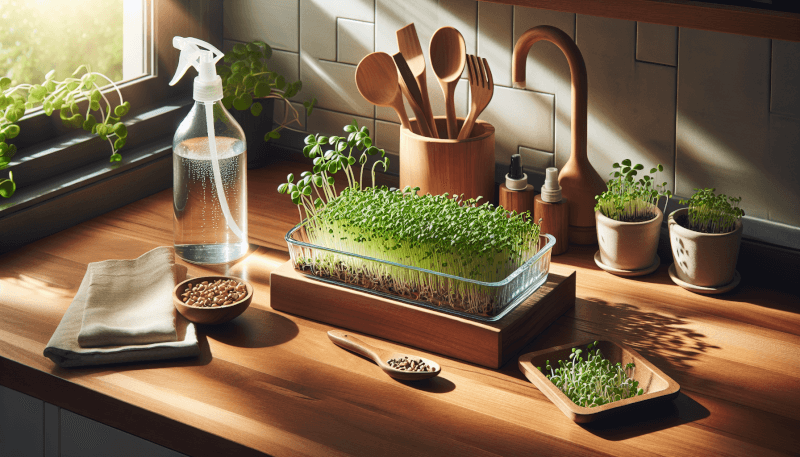Looking to add a touch of freshness to your homemade meals? Look no further – growing sprouts at home is the perfect solution! In this article, you will discover the simple and easy steps to cultivate your very own sprouts right in the comfort of your own kitchen. From choosing the right seeds to providing the ideal growing conditions, this guide will equip you with all the knowledge and tips you need to successfully grow delicious and nutritious sprouts. Get ready to embark on a journey of sustainable and healthy eating as we explore the wonderful world of sprout cultivation.

Choosing the Right Sprouts
Understanding the Different Types of Sprouts
When choosing sprouts to grow at home, it’s essential to understand the different types available. Sprouts come in various varieties, including alfalfa, broccoli, radish, mung bean, and many more. Each type of sprout has its unique flavor profile and nutritional benefits. Some sprouts are mild and crunchy, perfect for salads and sandwiches, while others have a stronger taste, ideal for adding a kick to your favorite recipes. Take your preferences and culinary needs into account when selecting the type of sprouts you want to grow.
Selecting Seeds for Sprouting
Selecting high-quality seeds is crucial for successful sprouting. Look for seeds specifically labeled for sprouting, as they have been treated and tested for optimal germination. Organic and non-GMO seeds are also recommended to ensure the highest possible quality. Additionally, consider the freshness of the seeds. The fresher the seeds, the better the sprouting results. Check the packaging date or try to purchase seeds from a reputable source. Taking these factors into account will help set you up for sprouting success.
Ensuring Seed Quality
To ensure the quality of the sprouts you grow, it’s important to pay attention to certain factors when selecting seeds. Look for seeds with a high germination rate, as this will increase your chances of successful sprouting. You can find this information on the seed packaging. Additionally, check for any signs of damage or discoloration on the seeds, as these could be indicators of poor quality. It’s also a good idea to purchase seeds from a trustworthy supplier and store them properly to maintain their freshness. By being diligent in choosing and storing your sprouting seeds, you can optimize the quality of your home-grown sprouts.
Preparing the Sprouting Equipment
Selecting a Sprouting Method
There are several methods to choose from when it comes to sprouting. Some popular options include using a sprouting jar, a sprouting bag, or a stackable sprouting tray. Each method has its advantages, and the choice ultimately depends on personal preference and the space available in your home. For beginners, a sprouting jar is a straightforward and convenient option. It allows you to easily rinse and drain the sprouts while keeping them contained. Research each method thoroughly to determine which one suits your needs best.
Gathering the Necessary Equipment
Before you start sprouting, gather all the necessary equipment. You’ll need a sprouting jar or a sprouting bag, as well as a mesh or screen lid to allow proper airflow and drainage. If using a stackable sprouting tray, ensure you have enough layers to accommodate the quantity of sprouts you intend to grow. Additionally, have a colander or strainer for rinsing the sprouts, and a clean towel or paper towels for drying. By having all the equipment ready beforehand, you can ensure a smooth sprouting process.
Sanitizing the Sprouting Equipment
To prevent the growth of harmful bacteria and ensure the cleanliness of your sprouting equipment, it’s crucial to sanitize it before every use. Thoroughly wash the sprouting jar, sprouting bag, or sprouting tray with warm, soapy water, paying particular attention to all crevices and corners. Rinse the equipment thoroughly to remove any trace of soap. You can also use a diluted bleach solution or hydrogen peroxide to sanitize the equipment. After sanitizing, allow the equipment to air dry completely before starting the sprouting process. This step will help minimize the risk of contamination and promote healthy sprout growth.
Soaking the Seeds
Measuring the Seeds
Proper measurement of the sprouting seeds is crucial for successful sprouting. Refer to the instructions on the seed packaging for guidance on the recommended quantity for soaking. In general, a tablespoon or two of seeds is sufficient for a small batch. However, if you’re sprouting larger quantities, adjust the measurements accordingly. Avoid overcrowding the sprouting jar or tray, as this can lead to poor airflow and increased moisture, which may result in mold growth. By measuring the seeds accurately, you can ensure optimal sprouting conditions.
Rinsing the Seeds
Before soaking the seeds, rinse them thoroughly to remove any dirt or debris. Place the seeds in a colander or strainer and run cool water over them, gently agitating them with your fingers. Continue rinsing until the water runs clear. This step is essential in preventing the introduction of any unwanted contaminants that could hinder the sprouting process. By thoroughly rinsing the seeds, you create a clean and conducive environment for sprout growth.
Soaking the Seeds
Once the seeds are rinsed, it’s time to soak them. Transfer the rinsed seeds into the sprouting jar, bag, or tray, and add enough clean water to cover them completely. Allow the seeds to soak for the recommended amount of time, usually between 8 to 12 hours or overnight. Soaking the seeds helps kickstart the sprouting process by softening the outer seed coat and activating enzymes that accelerate germination. Follow the instructions specific to the type of seeds you are sprouting to ensure optimal soaking time. By giving the seeds adequate time to soak, you set the stage for successful sprout development.

Rinsing and Draining
Rinsing Frequency
Rinsing the sprouts at regular intervals is crucial for their health and growth. Typically, sprouts should be rinsed twice a day. Rinse them in the morning and evening, ensuring each rinse is thorough and gentle. Use cool, clean water to flush away any waste or excess moisture. By rinsing the sprouts regularly, you help maintain proper hydration, remove any potential bacterial growth, and promote overall vitality.
Using Clean Water
When rinsing the sprouts, always use clean water. Tap water is generally acceptable, as long as it is of good quality. If you’re uncertain about the water quality, consider using filtered water or water that has been previously boiled and cooled. Avoid using chlorinated or heavily treated water, as such chemicals may hinder the sprouting process or affect the flavor of the sprouts. Using clean water during rinsing ensures the sprouts remain free from contaminants and provides them with the hydration they need.
Proper Drainage
After each rinse, it’s crucial to ensure proper drainage of the sprouts. The sprouting jar, bag, or tray should have adequate drainage holes or mesh to allow excess water to escape. After rinsing, gently tilt the sprouting vessel to remove any excess water. Avoid leaving the sprouts in standing water, as it can promote bacterial growth and cause the sprouts to become mushy or rot. Proper drainage promotes healthy airflow and prevents waterlogged conditions that are detrimental to sprout growth.
Providing Optimal Conditions
Ideal Sprouting Temperature
Maintaining the ideal temperature is key to promoting optimal sprout growth. Most sprouts thrive in a temperature range of 65 to 75 degrees Fahrenheit (18 to 24 degrees Celsius). Ensure the sprouting environment, whether it’s a countertop or a designated area, is within this temperature range. Avoid exposing the sprouts to extreme temperatures, such as direct sunlight or drafts. Consistent warmth will encourage the sprouts to grow at a steady pace and develop vibrant colors and flavors.
Proper Air Circulation
Adequate air circulation is essential for healthy sprouting. Proper airflow prevents the buildup of excess moisture, which can lead to mold or bacterial growth. Place the sprouting jars, bags, or trays in a well-ventilated area, away from any closed spaces or sealed containers. If necessary, use a fan on a low setting to promote air movement around the sprouting vessels. By prioritizing proper air circulation, you create an environment that supports robust and thriving sprout growth.
Avoiding Excess Humidity
Controlling humidity levels is vital when sprouting. Excessive humidity can lead to waterlogged conditions, which increase the risk of mold or bacterial growth. Ensure the sprouting area is well-ventilated and not overly humid. Avoid placing the sprouting vessels near areas with high moisture levels, such as the kitchen sink or a humidifier. If you live in a particularly humid climate, consider using a dehumidifier or a moisture absorber to maintain optimal moisture levels. By minimizing excess humidity, you create an environment that discourages unwanted microbial growth and promotes healthy sprouts.
Avoiding Contamination
Using Clean Water Sources
To prevent contamination of your sprouts, it’s crucial to use clean water sources. In addition to using clean water for rinsing, ensure the water you use for soaking and hydration is pure. Avoid using water from questionable sources, such as ponds or untreated wells. Instead, use tap water that has been tested for quality or opt for filtered water. Contaminated water can introduce harmful bacteria or chemicals that may compromise the safety of your sprouts. By using clean water sources, you reduce the risk of contamination and enjoy healthy, safe sprouts.
Preventing Mold and Bacterial Growth
Mold and bacterial growth can pose significant risks to your sprouts. To prevent these issues, practice good hygiene and sanitation throughout the sprouting process. Thoroughly sanitize the sprouting equipment before each use, as mentioned earlier. Additionally, ensure proper ventilation and drainage to discourage excess moisture that can lead to mold or bacterial growth. If you notice any signs of mold or foul odors, discard the affected sprouts immediately to prevent cross-contamination. By taking these preventive measures, you can minimize the risk of mold or bacterial growth and enjoy high-quality sprouts.
Avoiding Cross-contamination
Cross-contamination can occur when different batches of sprouts come into contact with one another or with contaminated surfaces. To avoid cross-contamination, keep each batch of sprouts separate and ensure their designated sprouting vessels are thoroughly cleaned between uses. Ideally, store the sprouting vessels in a clean, dry area away from potential sources of contamination, such as raw meats or chemicals. By practicing good sanitation and keeping batches separate, you maintain the integrity and safety of your sprouts.
Monitoring and Maintaining Sprouts
Regular Inspection
Regularly inspecting your sprouts is crucial for identifying any potential issues and ensuring their overall health. Keep a close eye on the growth progress, checking for any signs of discoloration, mushiness, or off-putting odors. Any abnormalities should be addressed promptly to prevent the spread of contamination. If you identify any unhealthy sprouts, remove them from the batch to prevent further damage. By conducting regular inspections, you can catch problems early on and maintain the quality of your sprouts.
Removing Unhealthy Sprouts
If you notice any sprouts that appear unhealthy or show signs of mold, discoloration, or foul smells, it’s important to remove them immediately. Unhealthy sprouts can compromise the health of the entire batch and increase the risk of cross-contamination. Carefully pluck out the affected sprouts using clean, sanitized hands or utensils. Discard the unhealthy sprouts and thoroughly sanitize the sprouting vessel to prevent the spread of any potential contaminants. By promptly removing unhealthy sprouts, you preserve the quality and safety of the remaining sprouts.
Maintaining Proper Moisture Levels
Proper moisture levels are essential for sprouts to thrive. Strive to maintain a consistent level of moisture throughout the sprouting process. If the sprouts appear too dry, gently mist them with clean water to provide additional moisture. On the other hand, if they seem overly wet or waterlogged, adjust the rinsing frequency and drainage to alleviate excess moisture. By monitoring and adjusting the moisture levels as needed, you create an environment that supports healthy sprout growth.
Harvesting the Sprouts
Determining Readiness for Harvest
Knowing when to harvest your sprouts is crucial for enjoying them at their peak freshness and flavor. Most sprouts are ready to harvest when they’ve developed their first set of true leaves or when they reach the desired length. Refer to the specific instructions for the type of sprouts you’re growing to determine the optimal harvest time. Taste test a few sprouts to ensure they have reached the desired texture and flavor. By observing the growth progress and sampling the sprouts, you can determine the perfect time to harvest and enjoy your home-grown goodness.
Harvesting Techniques
To harvest your sprouts, gently remove them from the sprouting vessel, being careful not to damage the delicate leaves or stems. You can pluck them individually or use clean scissors to trim the sprouts just above the root area. If any excess seed hulls remain, rinse the harvested sprouts with cool water and gently pat them dry with a clean towel or paper towels. Properly harvested sprouts will be fresh, crisp, and ready to enjoy in various culinary creations.
Storing and Preserving Sprouts
To extend the shelf life and freshness of your harvested sprouts, proper storage is key. After harvesting, rinse the sprouts one final time, gently removing any remaining seed hulls or debris. Thoroughly dry the sprouts using paper towels or a clean kitchen towel. Place the dry sprouts in an airtight container or a breathable storage bag and store them in the refrigerator. Ideally, use the sprouts within a few days to enjoy them at their peak flavor and nutritional value. Proper storage practices ensure your sprouts stay fresh and ready to enhance your meals with their vibrant crunch and nutrients.
Common Problems and Troubleshooting
Mold or Fungal Growth
If you encounter mold or fungal growth during the sprouting process, it’s essential to address it promptly to prevent further contamination. Mold can occur due to excess moisture, poor ventilation, or contamination from the sprouting equipment or water source. If mold appears, discard the affected sprouts immediately, sanitize the sprouting vessel, and adjust the moisture levels and airflow to prevent future occurrences. By identifying and addressing the causes of mold or fungal growth, you can maintain a healthy sprouting environment.
Unpleasant Odors
Unpleasant odors during the sprouting process can be a sign of bacterial growth or spoilage. If you notice any foul smells coming from your sprouts, it’s crucial to investigate the cause. Remove any sprouts that appear discolored, slimy, or emitting an off-putting odor. Sanitize the sprouting vessel and adjust the rinsing frequency and drainage to ensure optimal conditions. Proper hygiene and maintenance will help eliminate unpleasant odors and ensure the freshness and quality of your sprouts.
Uneven Sprouting
Uneven sprouting can occur due to factors such as inconsistent moisture levels, overcrowding, or poor seed quality. To address uneven sprouting, evaluate the moisture levels and adjust them as needed. If overcrowding is an issue, thin out the sprouts to allow for better airflow and prevent competition for resources. Additionally, ensure you’re using high-quality seeds with a good germination rate. By identifying and addressing the causes of uneven sprouting, you can encourage more uniform growth and achieve better overall sprout yields.
Exploring Different Sprout Recipes
Sprouts for Salads and Sandwiches
Sprouts add a delightful crunch and freshness to salads and sandwiches. Experiment with different combinations of sprouts to enhance your favorite recipes. Alfalfa sprouts are a classic choice, offering a mild and slightly nutty flavor. Radish or broccoli sprouts can add a pleasant spiciness, while mung bean sprouts provide a hearty and crunchy texture. Mix and match sprouts with your preferred vegetables, dressings, and proteins to create flavorful and nutrient-packed salads and sandwiches.
Cooking with Sprouts
Sprouts can also be cooked to add a unique texture and flavor to various dishes. Stir-fry is a popular way to incorporate sprouts into a warm and savory meal. Add them towards the end of the cooking process to retain their crispness. You can also steam or blanch sprouts briefly for a tender and delicate addition to soups, stews, or pasta dishes. The cooking process can mellow out the sprout’s flavors, making them more versatile in a range of recipes.
Creative Sprout Combos
Get creative with your sprout combinations to add interesting flavors and textures to your culinary creations. Mix different sprouts together to create your unique blend. For example, combine clover sprouts with sunflower sprouts for a subtle, earthy taste, or mix spicy radish sprouts with delicate pea shoots for a contrasting flavor profile. The possibilities are endless, and exploring different sprout combinations can elevate your dishes and turn them into nutritious and visually appealing masterpieces.
In conclusion, growing sprouts at home is an exciting and rewarding process. By understanding the different types of sprouts, selecting high-quality seeds, and providing optimal sprouting conditions, you can enjoy fresh and nutritious sprouts in your everyday meals. Practice good sanitation, monitor and maintain your sprouts, and troubleshoot any problems that arise. With a little time and effort, you’ll be harvesting and enjoying a variety of sprouts right from your own kitchen, adding a burst of flavor and nutrition to your favorite dishes. So go ahead, embark on your sprouting journey, and savor the goodness of home-grown sprouts!




